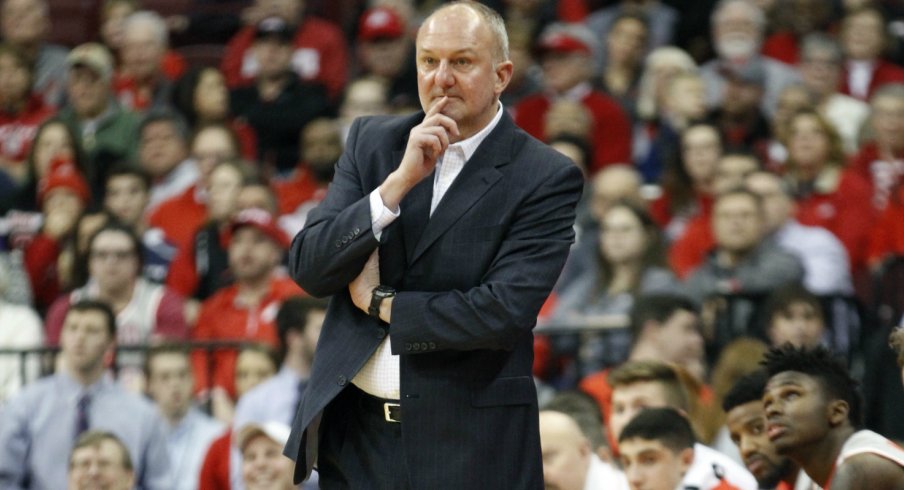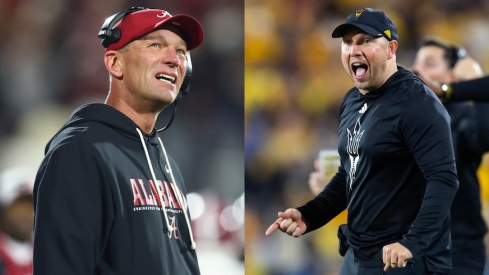Overall, Ohio State's defense hasn't been a problem this season. The Buckeyes are No. 28 in KenPom's defensive efficiency rankings and often put their defense in a precarious position by committing turnovers.
A couple of lapses on that end cost OSU an upset win at home over Maryland. In Madison, Thursday, these issues continued throughout the entire game. The Badgers hit 13 of their 27 three-point attempts, many of which were open because of some preventable defensive breakdowns.
Wisconsin starting point guard Bronson Koenig hit 38 percent of his three-point shots this season, down a couple percentage points from last season. A year ago, according to DraftExpress.com, he finished in the 88th percentile of the NCAA by 1.123 points per jump shot. Those attempts were almost evenly split between pull-ups and spot-up jumpers.
All of which is to say: you shouldn't leave Koenig open, be it leaving him while he's off ball or going underneath a ball screen and giving him a good look on a spot-up attempt.
Nigel Hayes is tough to defend one-on-one in the post. However, there's no need to leave Koenig to help on Hayes when Hayes is 15 feet away from the rim with his back to the basket and Koenig is only one pass away:
Koenig is equally dangerous with the ball in his hands. On this next play, a miscommunication on pick and roll coverage allowed him to get an open shot.
Keita Bates-Diop picked up Koenig in transition and decided to switch onto Ethan Happ when Happ slipped the screen. Credit Koenig for a nifty behind-the-back dribble to initiate the launch into his jumper, but Marc Loving backed off rather than running Koenig off the shot:
Koenig missed this next shot and three other attempts from beyond the arc. Given the previous evidence, however, it is unwise to go underneath a ball screen when Koenig has the ability to step into a three. Granted, Happ should've been called for a moving screen here:
Koenig wasn't the only Badger the Buckeyes had trouble covering. Although he isn't a high-volume shooter, Alex Illikainen capable of hitting threes and he knocked down a pair, Thursday.
Wisconsin only produced two fast-break points but Ohio State still had issues in transition, even with all five guys back. The Bates-Diop and Loving miscommunication above is one example, up next is a more glaring one.
Kam Williams leaves Khalil Iverson, as both him and A.J. Harris run towards the open Badger at the top of the key. They proceed to watch the ball in the post rather than cover Illikainen on the wing. Loving had to leave Illikainen to protect the rim while an open Iverson cuts to the basket. Proper communication between the three could've prevented this:
Sloppy defensive rotations plagued the Buckeyes through the first 30 minutes of the game. Moments after the Illikainen three, Thad Matta went to a small lineup with 9:17 remaining and it sparked the OSU defense. Over the next 6:20, Wisconsin only hit two field goals and Ohio State climbed back within a bucket.
A lineup featuring Jae'Sean Tate, JaQuan Lyle, Loving, Bates-Diop and Williams switched every ball screen. They heavily pressured the Badgers and forced three turnovers. This possession ended in a shot clock violation:
Tate was his usual, aggressive self. He picked up four fouls but was the catalyst of the defensive turnaround:
That kind of aggressive switching can wear a team out, especially since it was implemented towards the end of the second half. Perhaps it led to this mental lapse – as Bates-Diop lost track of Jordan Hill and helped Tate in the low post only one pass away:
Personally, Matta's use of the small lineup was the most interesting takeaway from this game. It will prove to be useful against any team that can spread the floor like the Badgers and when Matta doesn't feel comfortable with Trevor Thompson or Daniel Giddens straying far from the rim.


